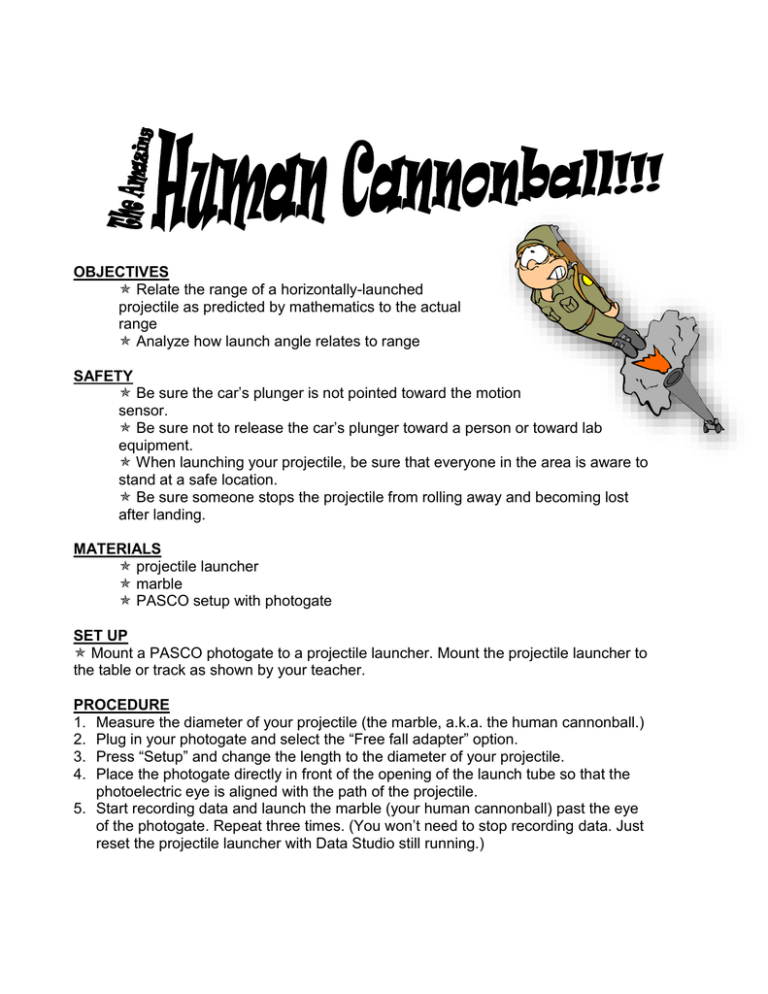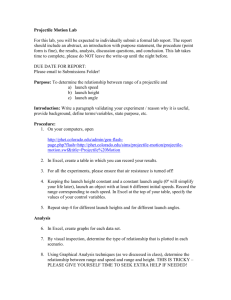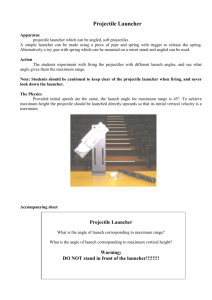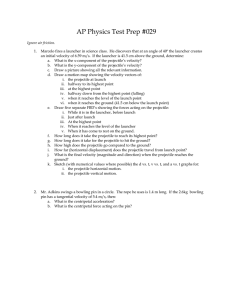Human Cannonball Projectiles Lab
advertisement

OBJECTIVES Relate the range of a horizontally-launched projectile as predicted by mathematics to the actual range Analyze how launch angle relates to range SAFETY Be sure the car’s plunger is not pointed toward the motion sensor. Be sure not to release the car’s plunger toward a person or toward lab equipment. When launching your projectile, be sure that everyone in the area is aware to stand at a safe location. Be sure someone stops the projectile from rolling away and becoming lost after landing. MATERIALS projectile launcher marble PASCO setup with photogate SET UP Mount a PASCO photogate to a projectile launcher. Mount the projectile launcher to the table or track as shown by your teacher. PROCEDURE 1. Measure the diameter of your projectile (the marble, a.k.a. the human cannonball.) 2. Plug in your photogate and select the “Free fall adapter” option. 3. Press “Setup” and change the length to the diameter of your projectile. 4. Place the photogate directly in front of the opening of the launch tube so that the photoelectric eye is aligned with the path of the projectile. 5. Start recording data and launch the marble (your human cannonball) past the eye of the photogate. Repeat three times. (You won’t need to stop recording data. Just reset the projectile launcher with Data Studio still running.) 6. Find the average time from the three launches. Use this time and the width of your projectile to determine the initial launch velocity of your projectile. Jot down your calculations so that you remember what to include in your data analysis section. 7. Knowing the initial velocity, predict mathematically where the projectile will land (horizontal displacement) for a horizontal launch. You will need to show this calculation in your Data Analysis section when you do your lab report, so be sure to keep track of your scratch work. 8. Hold your meterstick perfectly vertically up against the edge of your table so that you can find the spot on the floor that’s directly below the ramp’s edge. Put a tiny piece of tape or light pencil mark on the floor there. In front of the piece of tape measure the distance you found to be the “horizontal distance” and place your landing pad1 at this exact location. Be sure when you do this that the landing pad is directly lined up laterally (i.e., left-to-right) with the path the daredevil takes from the launch ramp. 9. Launch your human cannonball! Watch carefully where s/he actually lands and mark the spot. Measure this horizontal displacement from the table and record the value. 10. Calculate the percent error between your predicted landing position (step seven) and your actual landing position (step nine.) You will show these calculations in your data analysis section. 11. Now you are done with calculations and computerized data collection. HOWEVER, you are not done with the lab. You will raise the angle of the projectile launcher by 10° increments from 20° through 70°. Record the horizontal displacement for each of these in a data table that also includes the horizontal displacements for the horizontal (0°) launch and the 10° launch. (Don’t worry about using PASCO for this step.) 12. Create a scatter plot in Excel of the horizontal displacement versus launch angle data. DATA TABLES AND GRAPHS Horizontal launch: Predicted landing position (horizontal displacement from table) Horizontal launch: Actual landing position (horizontal displacement from table) Angled launches: the horizontal displacement data for each angled launch Angled launches: the scatter plot 1 Your landing pad is the target on the last page of the lab. DATA ANALYSIS In your lab report, please be sure to include: the calculation you used to find the initial launch velocity for the horizontal launch. the calculations you used to find the predicted landing position for the horizontal launch. the percent error between your predicted landing position and the actual landing position from step ten. CONCLUSION Write a conclusion that addresses what the data reveals about the objectives. COMMENTS Make two academic comments.








